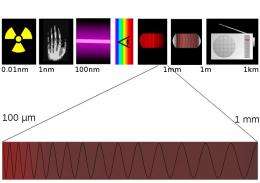T-ray madness: Scientists score wireless data record (original) (raw)

Location of Terahertz waves in the electromagnetic spectrum. Image: Wikipedia.
(Phys.org) -- Wednesday headlines trumpeted how "Japanese researchers smash Wi-Fi records" and "Scientists show off the future of Wi-Fi." The excitement is for good reason. A team of scientists have broken the record for wireless data transmission. They showed that they were capable of transmitting data at 3Gb/at frequencies up to 542GHz. They have done so in uncharted territory, so to speak, the terahertz band, a part of the electromagnetic spectrum that is currently unregulated. They reported success in making Wi-Fi twenty times faster.
Their breaking through the 3Gbps barrier is seen as enticing news for a future where broadband users can get impressively high data rates and broadband speeds The terahertz, or "T-ray," region is part of the electromagnetic spectrum between 300 GHz and 3 THz.
Research sites performing imaging make use of terahertz because it is a less damaging alternative to x-rays, in that terahertz waves can penetrate materials but deposit less energy.
Outside such settings, where heavy and costly machines are at work, the spectrum has not been considered as a practical solution for daily use. The researchers’ work may make such considerations plausible. The team developed specialized hardware that was capable of achieving the 3Gb data transmission. They made use of resonant tunneling diode, which produces smaller voltages with increasing current, i.e., the voltage decreased as the current increased. “By tuning the current, the team could make the device resonate and spit out signals in the terahertz band,”as Gizmodo commented.
Findings of the T-ray researchers, who are from the Tokyo Institute of Technology, have been, published in Electronics Letters. The study suggests that Wi-Fi using the system may support data transmission rates of up to 100 Gbit/s. The researchers note that terahertz Wi-Fi, however, would probably only work for ranges up to 10 meters, but data transmission within that range would be orders of magnitude higher than current alternatives. Their research is still a work in progress, and they intend to extend the range.
Beyond their research, Wi-Fi watchers expect favorable progress to come from the new standard 802.11ac, which is said to be the next evolutionary stage of wireless networking.
More information: Direct intensity modulation and wireless data transmission characteristics of terahertz-oscillating resonant tunnelling diodes, Electron. Lett. -- 10 May 2012 -- Volume 48, Issue 10, p.582–583. dx.doi.org/10.1049/el.2012.0849
Abstract
Direct intensity modulation and wireless data transmission characteristics of terahertz-oscillating resonant tunnelling diodes (RTDs) is reported. A direct intensity modulation of the RTD oscillators was demonstrated, and the frequency response was measured. It was found that the 3 dB cutoff modulation frequency was limited by the parasitic elements of the external circuit, and increased up to 4.5 GHz by reducing such parasitic elements. Wireless data transmission by direct amplitude shift keying was demonstrated using an RTD oscillating at 542 GHz with cutoff frequency of 1.1 GHz. The BERs for bit rates of 2 and 3 Gbit/s were found to be 2×10−8 and 3×10−5, respectively.
© 2012 Phys.Org
Citation: T-ray madness: Scientists score wireless data record (2012, May 16) retrieved 19 November 2024 from https://phys.org/news/2012-05-t-ray-madness-scientists-score-wireless.html
This document is subject to copyright. Apart from any fair dealing for the purpose of private study or research, no part may be reproduced without the written permission. The content is provided for information purposes only.